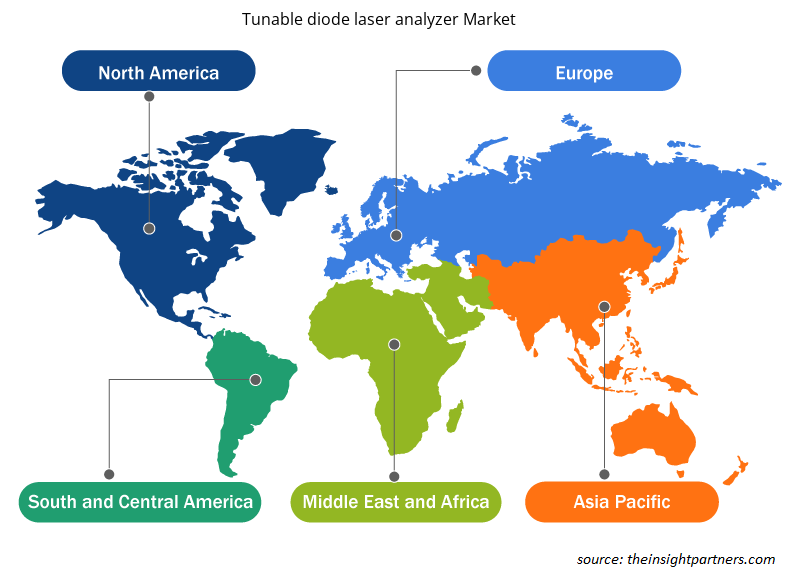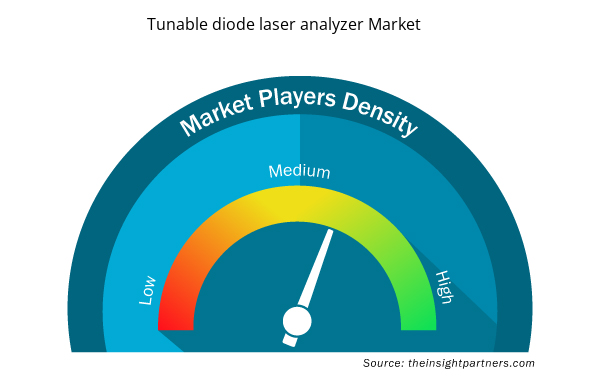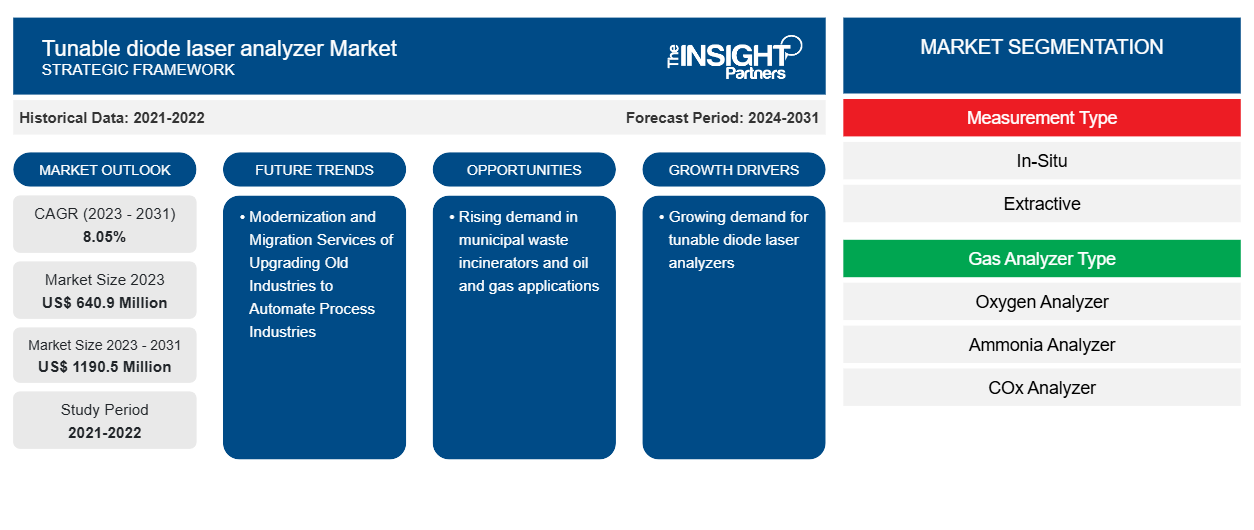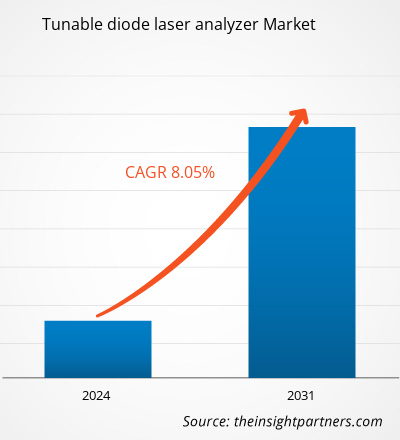チューナブルダイオードレーザー分析装置の市場規模は、2023年の6億4,090万米ドルから2031年には1億1,905万米ドルに達すると予測されています。市場は2023年から2031年の間に8.05%のCAGRを記録すると予想されています。都市ごみ焼却炉や石油・ガス用途の需要増加は、今後も市場の主要なトレンドであり続けると思われます。
チューナブルダイオードレーザーアナライザー市場分析
チューナブル ダイオード レーザー分析装置 (TDL) は、チューナブル ダイオード レーザー吸収分光法 (TDLAS) を使用して、空気サンプル内の微量ガスの量を評価します。この方法により、高い選択性、速度、感度が実現します。さらに、この技術は、測定の速度と精度、およびバックグラウンド ガスに対する耐性で知られています。このシステムは、コンプライアンスとプロセス監視の両方を目的として排気ガスを測定するように設計された連続モニターです。
チューナブルダイオードレーザー分析装置市場概要
チューナブル ダイオード レーザー分析装置 (TDL 分析装置) は、レーザー吸収分光法を使用して、ガス混合物内の特定の種の濃度を測定します。TDL 分析装置は、メンテナンスが少なく、バックグラウンド ガスの影響を受けずに迅速かつ正確に測定できることで知られています。チューナブル ダイオード レーザー分析装置は、主に酸素測定に使用されます。厳しいプロセス環境でさまざまな近赤外線吸収ガスを監視でき、非常に高温、高圧、および厳しい環境 (腐食性、攻撃性、高粒子サービス) での測定が可能です。濃度、温度、圧力、および流速は、ガスの特性と成分を分析するために最もよく使用される手法の一部です。TDLAS は、ガス媒体による波長依存の光吸収を検出します。
要件に合わせてレポートをカスタマイズする
このレポートの一部、国レベルの分析、Excelデータパックなど、あらゆるレポートを無料でカスタマイズできます。また、スタートアップや大学向けのお得なオファーや割引もご利用いただけます。
- このレポートの主要な市場動向を入手してください。この無料サンプルには、市場動向から見積もりや予測に至るまでのデータ分析が含まれます。
チューナブルダイオードレーザーアナライザー市場の推進要因と機会
需要増加によるチューナブルダイオードレーザー分析装置の市場への好影響
工業プロセスでは、TDL (チューナブル ダイオード レーザー) ガス センサーの使用がますます一般的になっています。TDL 分析装置はプロセス内で直接測定できるため、ドリフトや相互干渉が排除されます。他のタイプのガス分析装置と比較すると、購入、設置、保守にかかる費用がはるかに安価です。TDL ガス分析装置は、さまざまな分野で利用されています。化学、石油化学、製薬、食品飲料の各分野での設置が一般的です。ブランケット アプリケーションでは、ガス分析装置で非パージ プローブを使用すると、安全性が向上し、運用コストが削減されます。
さらに、対象ガスに極めて特化した高速かつ正確な測定を提供します。そのため、その幅広い用途により需要が高まっています。このように、需要の高まりが市場の成長を牽引しています。
旧来の産業を自動化プロセス産業にアップグレードする近代化および移行サービス
チューナブル ダイオード レーザー (TDL) 分析装置は、さまざまな業界でガス放出の測定やさまざまなプロセス ガスの測定に使用される自動化技術です。自動化はさまざまな業界で広く使用されています。工業化が進むにつれて、デノックス システムやボイラーなどの複雑なシステムに対する需要が高まっています。これらのシステムは、主に正確なガス測定に依存しており、TDLA は精度と信頼性により優れています。したがって、古い業界をアップグレードしてプロセス業界を自動化する近代化および移行サービスにより、チューナブル ダイオード レーザー分析装置市場の成長機会が生まれています。
チューナブルダイオードレーザーアナライザー市場レポートセグメンテーション分析
チューナブルダイオードレーザー分析装置市場分析の導出に貢献した主要なセグメントは、測定タイプ、ガス分析装置タイプ、および業界アプリケーションです。
- 測定タイプに基づいて、チューナブルダイオードレーザーアナライザー市場は、in-situ と抽出に分類されます。
- ガス分析装置の種類に基づいて、波長可変ダイオードレーザー分析装置市場は、酸素分析装置、アンモニア分析装置、COx分析装置、水分分析装置、Hx分析装置、CxHx分析装置などに分類されます。
- 業界アプリケーションに基づいて、チューナブルダイオードレーザーアナライザー市場は、電力、石油・ガス、鉱業・金属、化学薬品、肥料、セメント、その他に分類されます。
波長可変ダイオードレーザー分析装置 地域別市場シェア分析
チューナブルダイオードレーザー分析装置市場レポートの地理的範囲は、主に北米、アジア太平洋、ヨーロッパ、中東およびアフリカ、南米および中米の 5 つの地域に分かれています。北米のチューナブルダイオードレーザー分析装置市場は、米国、カナダ、メキシコに区分されています。北米ではさまざまな業界で自動化が採用されており、これが市場の成長を牽引しています。さらに、ヨーロッパの製造企業は、ビジネスプロセスの効率を向上させるために、デジタル変革ソリューションを採用するよう求められています。さらに、競争が激化し、エンドユーザーが変化を求めると、彼らはより新しい技術開発を採用します。
チューナブルダイオードレーザーアナライザー市場地域別インサイト
予測期間を通じてチューナブル ダイオード レーザー アナライザー市場に影響を与える地域的な傾向と要因は、Insight Partners のアナリストによって徹底的に説明されています。このセクションでは、北米、ヨーロッパ、アジア太平洋、中東、アフリカ、南米、中米にわたるチューナブル ダイオード レーザー アナライザー市場のセグメントと地理についても説明します。

- チューナブルダイオードレーザー分析装置市場の地域別データを入手
チューナブルダイオードレーザーアナライザー市場レポートの範囲
| レポート属性 | 詳細 |
|---|---|
| 2023年の市場規模 | 6億4,090万米ドル |
| 2031年までの市場規模 | 11億9,050万米ドル |
| 世界のCAGR(2023年~2031年) | 8.05% |
| 履歴データ | 2021-2022 |
| 予測期間 | 2024-2031 |
| 対象セグメント | 測定タイプ別
|
| 対象地域と国 | 北米
|
| 市場リーダーと主要企業プロフィール |
|
チューナブルダイオードレーザーアナライザー市場のプレーヤー密度:ビジネスダイナミクスへの影響を理解する
チューナブル ダイオード レーザー アナライザー市場は、消費者の嗜好の変化、技術の進歩、製品の利点に対する認識の高まりなどの要因により、エンド ユーザーの需要が高まり、急速に成長しています。需要が高まるにつれて、企業は提供内容を拡大し、消費者のニーズを満たすために革新し、新たなトレンドを活用し、市場の成長をさらに促進しています。
市場プレーヤー密度とは、特定の市場または業界内で活動している企業または会社の分布を指します。これは、特定の市場スペースに、その市場規模または総市場価値に対してどれだけの競合相手 (市場プレーヤー) が存在するかを示します。
チューナブルダイオードレーザーアナライザー市場で事業を展開している主要企業は次のとおりです。
- エマーソンエレクトリック社
- シーメンスAG
- ABB株式会社
- メトラー・トレド
- テレダイン分析機器
- 横河電機株式会社
免責事項:上記の企業は、特定の順序でランク付けされていません。

- チューナブルダイオードレーザーアナライザー市場のトップキープレーヤーの概要を入手
チューナブルダイオードレーザーアナライザーの市場ニュースと最近の動向
チューナブル ダイオード レーザー アナライザー市場は、重要な企業出版物、協会データ、データベースなどの一次調査と二次調査後の定性的および定量的データを収集することによって評価されます。チューナブル ダイオード レーザー アナライザー市場の開発のいくつかを以下に示します。
- 横河コーポレーション オブ アメリカは、新世代の OpreX アナライザー製品である抽出型チューナブル ダイオード レーザー分光計 TDLS8220 をリリースしました。この製品は、横河の既存のラインナップに加わり、in-situ TDLS8000 およびプローブ タイプ TDLS8100/TDLS8200 が含まれます。横河の第 2 世代 TDLS アナライザーをベースに構築された TDLS8220 は、信頼性の向上、応答時間の短縮、メンテナンスの削減を実現しており、第 1 世代 TDLS220 の直接的な代替品です。
(出典:横河電機株式会社、2024年2月)
- ABB は、Off-Axis Integrated Cavity Output Spectroscopy (OA-ICOS) と呼ばれる独自の波長可変ダイオード レーザー (TDL) 技術をベースにしたコンパクトな天然ガス汚染物質分析装置 Sensi+ を発表しました。この技術は、複雑で時間とともに変化する天然ガス流中の硫化水素、二酸化炭素、水 →01-02 などの腐食性物質を、正確かつ確実に、同時にリアルタイムで測定します。
- (出典:ABB、2023年4月)
チューナブルダイオードレーザーアナライザー市場レポートのカバー範囲と成果物
「チューナブルダイオードレーザーアナライザー市場規模と予測(2021〜2031年)」レポートでは、以下の分野をカバーする市場の詳細な分析を提供しています。
- 範囲に含まれるすべての主要な市場セグメントについて、世界、地域、国レベルでのチューナブルダイオードレーザー分析装置の市場規模と予測
- チューナブルダイオードレーザー分析装置の市場動向、および推進要因、制約、主要な機会などの市場動向
- 詳細なPEST/ポーターの5つの力とSWOT分析
- 主要な市場動向、世界および地域の枠組み、主要プレーヤー、規制、最近の市場動向を網羅したチューナブルダイオードレーザー分析装置市場分析
- 市場集中、ヒートマップ分析、主要プレーヤー、チューナブルダイオードレーザー分析装置市場の最近の動向を網羅した業界展望と競争分析
- 詳細な企業プロフィール
- 過去2年間の分析、基準年、CAGRによる予測(7年間)
- PEST分析とSWOT分析
- 市場規模価値/数量 - 世界、地域、国
- 業界と競争環境
- Excel データセット


- Small Internal Combustion Engine Market
- Europe Surety Market
- Mesotherapy Market
- Collagen Peptides Market
- Rugged Servers Market
- Electronic Toll Collection System Market
- Single-Use Negative Pressure Wound Therapy Devices Market
- Lyophilization Services for Biopharmaceuticals Market
- Organoids Market
- Europe Industrial Chillers Market

Report Coverage
Revenue forecast, Company Analysis, Industry landscape, Growth factors, and Trends

Segment Covered
This text is related
to segments covered.

Regional Scope
North America, Europe, Asia Pacific, Middle East & Africa, South & Central America

Country Scope
This text is related
to country scope.
よくある質問
The market is expected to register a CAGR of 8.05 % during 2023–2031.
The global Tunable diode laser analyzer market is expected to reach US$ 1190.5 million by 2031.
The leading players operating in the global Tunable diode laser analyzer market are Emerson Electric Co., Siemens AG, ABB Ltd, Mettler Toledo, Teledyne Analytical Instruments, Yokogawa Electric Corporation, Unisearch Associates Inc., NEO Monitors AS, Axetris AG, and Boreal Laser Inc.
Rising demand in municipal waste incinerators and oil and gas applications to play a significant role in the global Tunable diode laser analyzer market in the coming years.
Growing demand for tunable diode laser analyzers is the major factors that propel the global Tunable diode laser analyzer market.
North America dominated the Tunable diode laser analyzer market in 2023.
Trends and growth analysis reports related to Electronics and Semiconductor : READ MORE..
The Insight Partners performs research in 4 major stages: Data Collection & Secondary Research, Primary Research, Data Analysis and Data Triangulation & Final Review.
- Data Collection and Secondary Research:
As a market research and consulting firm operating from a decade, we have published and advised several client across the globe. First step for any study will start with an assessment of currently available data and insights from existing reports. Further, historical and current market information is collected from Investor Presentations, Annual Reports, SEC Filings, etc., and other information related to company’s performance and market positioning are gathered from Paid Databases (Factiva, Hoovers, and Reuters) and various other publications available in public domain.
Several associations trade associates, technical forums, institutes, societies and organization are accessed to gain technical as well as market related insights through their publications such as research papers, blogs and press releases related to the studies are referred to get cues about the market. Further, white papers, journals, magazines, and other news articles published in last 3 years are scrutinized and analyzed to understand the current market trends.
- Primary Research:
The primarily interview analysis comprise of data obtained from industry participants interview and answers to survey questions gathered by in-house primary team.
For primary research, interviews are conducted with industry experts/CEOs/Marketing Managers/VPs/Subject Matter Experts from both demand and supply side to get a 360-degree view of the market. The primary team conducts several interviews based on the complexity of the markets to understand the various market trends and dynamics which makes research more credible and precise.
A typical research interview fulfils the following functions:
- Provides first-hand information on the market size, market trends, growth trends, competitive landscape, and outlook
- Validates and strengthens in-house secondary research findings
- Develops the analysis team’s expertise and market understanding
Primary research involves email interactions and telephone interviews for each market, category, segment, and sub-segment across geographies. The participants who typically take part in such a process include, but are not limited to:
- Industry participants: VPs, business development managers, market intelligence managers and national sales managers
- Outside experts: Valuation experts, research analysts and key opinion leaders specializing in the electronics and semiconductor industry.
Below is the breakup of our primary respondents by company, designation, and region:

Once we receive the confirmation from primary research sources or primary respondents, we finalize the base year market estimation and forecast the data as per the macroeconomic and microeconomic factors assessed during data collection.
- Data Analysis:
Once data is validated through both secondary as well as primary respondents, we finalize the market estimations by hypothesis formulation and factor analysis at regional and country level.
- Macro-Economic Factor Analysis:
We analyse macroeconomic indicators such the gross domestic product (GDP), increase in the demand for goods and services across industries, technological advancement, regional economic growth, governmental policies, the influence of COVID-19, PEST analysis, and other aspects. This analysis aids in setting benchmarks for various nations/regions and approximating market splits. Additionally, the general trend of the aforementioned components aid in determining the market's development possibilities.
- Country Level Data:
Various factors that are especially aligned to the country are taken into account to determine the market size for a certain area and country, including the presence of vendors, such as headquarters and offices, the country's GDP, demand patterns, and industry growth. To comprehend the market dynamics for the nation, a number of growth variables, inhibitors, application areas, and current market trends are researched. The aforementioned elements aid in determining the country's overall market's growth potential.
- Company Profile:
The “Table of Contents” is formulated by listing and analyzing more than 25 - 30 companies operating in the market ecosystem across geographies. However, we profile only 10 companies as a standard practice in our syndicate reports. These 10 companies comprise leading, emerging, and regional players. Nonetheless, our analysis is not restricted to the 10 listed companies, we also analyze other companies present in the market to develop a holistic view and understand the prevailing trends. The “Company Profiles” section in the report covers key facts, business description, products & services, financial information, SWOT analysis, and key developments. The financial information presented is extracted from the annual reports and official documents of the publicly listed companies. Upon collecting the information for the sections of respective companies, we verify them via various primary sources and then compile the data in respective company profiles. The company level information helps us in deriving the base number as well as in forecasting the market size.
- Developing Base Number:
Aggregation of sales statistics (2020-2022) and macro-economic factor, and other secondary and primary research insights are utilized to arrive at base number and related market shares for 2022. The data gaps are identified in this step and relevant market data is analyzed, collected from paid primary interviews or databases. On finalizing the base year market size, forecasts are developed on the basis of macro-economic, industry and market growth factors and company level analysis.
- Data Triangulation and Final Review:
The market findings and base year market size calculations are validated from supply as well as demand side. Demand side validations are based on macro-economic factor analysis and benchmarks for respective regions and countries. In case of supply side validations, revenues of major companies are estimated (in case not available) based on industry benchmark, approximate number of employees, product portfolio, and primary interviews revenues are gathered. Further revenue from target product/service segment is assessed to avoid overshooting of market statistics. In case of heavy deviations between supply and demand side values, all thes steps are repeated to achieve synchronization.
We follow an iterative model, wherein we share our research findings with Subject Matter Experts (SME’s) and Key Opinion Leaders (KOLs) until consensus view of the market is not formulated – this model negates any drastic deviation in the opinions of experts. Only validated and universally acceptable research findings are quoted in our reports.
We have important check points that we use to validate our research findings – which we call – data triangulation, where we validate the information, we generate from secondary sources with primary interviews and then we re-validate with our internal data bases and Subject matter experts. This comprehensive model enables us to deliver high quality, reliable data in shortest possible time.


 このレポートの無料サンプルを入手する
このレポートの無料サンプルを入手する